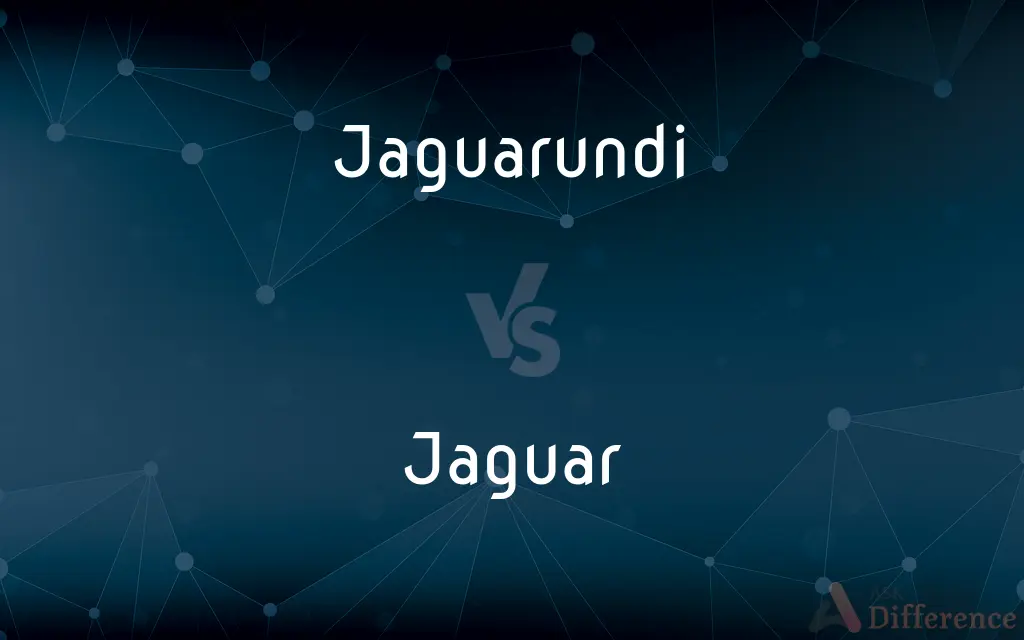Jaguarundi vs. Jaguar — What's the Difference?
By Fiza Rafique & Urooj Arif — Updated on April 3, 2024
The Jaguarundi is small, sleek wild cat, often found in Central and South America, known for its elongated body and short legs, while Jaguar, larger and more powerful, roams Americas' forests, recognized for its spotted coat and formidable strength.

Difference Between Jaguarundi and Jaguar
Table of Contents
ADVERTISEMENT
Key Differences
The Jaguarundi and the Jaguar are two distinct species of wild cats native to the Americas, with differences in size, habitat, and behavior that set them apart. The Jaguarundi, with its small size and elongated body, contrasts sharply with the larger and more powerful Jaguar, known for its muscular build and distinctive spotted coat. While the Jaguarundi prefers a varied habitat ranging from arid regions to dense forests and is known for its terrestrial and arboreal lifestyle, the Jaguar primarily inhabits dense rainforests and is an excellent swimmer, often found near water bodies.
Both cats are solitary and territorial, but their methods of hunting and diet differ significantly. The Jaguarundi hunts during the day, feeding on smaller prey such as rodents, birds, and reptiles. On the other hand, the Jaguar is a formidable predator at the top of the food chain, preying on larger animals such as deer, caimans, and capybaras, using its powerful bite to pierce the skulls or necks of its prey.
Conservation status also highlights differences between these species. The Jaguarundi, though less known, faces threats from habitat destruction and fragmentation, but its population is not as critically endangered as that of the Jaguar, which is listed as near threatened due to deforestation, poaching, and conflict with humans. Conservation efforts are in place to protect both species, with a particular focus on preserving the Jaguar's habitat and preventing illegal hunting.
Reproductive behaviors exhibit further distinctions. Jaguarundis have a relatively short gestation period and can reproduce twice a year, contributing to their resilience in varying environments. Jaguars, however, have a longer gestation period and typically produce fewer offspring, with their cubs requiring extensive parental care for up to two years, highlighting the importance of stable, protected habitats for their survival.
Despite these differences, both the Jaguarundi and the Jaguar play crucial roles in their ecosystems as predators, helping to maintain the balance by controlling other species' populations. Their presence indicates healthy, biodiverse environments, underscoring the importance of their conservation for the overall health of their habitats.
ADVERTISEMENT
Comparison Chart
Size
Small, with an elongated body and short legs
Large and muscular with a robust build
Habitat
Varied, from arid regions to dense forests
Dense rainforests, often near water
Diet
Small prey like rodents, birds, reptiles
Larger prey like deer, caimans, capybaras
Conservation Status
Less known, faces habitat destruction
Near threatened, suffers from deforestation, poaching
Reproductive Behavior
Short gestation, can reproduce twice a year
Longer gestation, cubs require extensive care
Compare with Definitions
Jaguarundi
Solitary and territorial.
Jaguarundis lead solitary lives, marking their territory with scent.
Jaguar
Endangered status.
The Jaguar faces threats from habitat loss and is considered near threatened.
Jaguarundi
Small wild cat.
The Jaguarundi, a small wild cat, is often mistaken for a weasel due to its elongated body.
Jaguar
Spotted coat.
Jaguars are renowned for their beautiful spotted coats, which aid in camouflage.
Jaguarundi
Daytime hunter.
Unlike many wild cats, the Jaguarundi hunts primarily during the day.
Jaguar
Strong bite.
With one of the strongest bites among big cats, Jaguars can pierce turtle shells.
Jaguarundi
Conservation concerns.
Habitat destruction poses a significant threat to the Jaguarundi's survival.
Jaguar
Aquatic ability.
Jaguars are adept swimmers, often hunting in and around water bodies.
Jaguarundi
Versatile habitat.
Jaguarundis adapt to various habitats, from arid environments to dense forests.
Jaguar
Large apex predator.
The Jaguar, an apex predator, dominates the ecosystems of the Americas.
Jaguarundi
The jaguarundi (Herpailurus yagouaroundi) is a wild cat native to the Americas. Its range extends from central Argentina in the south to northern Mexico, through Central and South America east of the Andes.
Jaguar
The jaguar (Panthera onca) is a large felid species and the only living member of the genus Panthera native to the Americas. Its distinctively marked coat features pale yellow to tan colored fur covered by spots that transition to rosettes on the sides.
Jaguarundi
A small American wild cat with a uniform red or grey coat, slender body, and short legs, found from Arizona to Argentina.
Jaguar
A large feline mammal (Panthera onca) of Mexico, Central America, and South America, closely related to the leopard and having a tawny coat spotted with black rosettes.
Jaguarundi
A long-tailed, grayish-brown or reddish wildcat (Puma yagouaroundi) of southern North America and Central and South America. The jaguarundi is sometimes classified in the genus Felis or Herpailurus.
Jaguar
A carnivorous spotted large cat native to South and Central America, Panthera onca.
Jaguarundi
A medium-sized Central and South American wild cat, Puma yagouaroundi, Herpailurus yagouaroundi or Felis yagouaroundi.
Jaguar
A large and powerful feline animal (Panthera onca, formerly Felis onca), ranging from Texas and Mexico to Patagonia. It is usually brownish yellow, with large, dark, somewhat angular rings, each generally inclosing one or two dark spots. It is chiefly arboreal in its habits. It is also called the panther and the American tiger.
Jaguarundi
Long-bodied long-tailed tropical American wildcat
Jaguar
A large spotted feline of tropical America similar to the leopard; in some classifications considered a member of the genus Felis
Common Curiosities
What is the conservation status of the Jaguar?
The Jaguar is listed as near threatened, primarily due to habitat loss and poaching.
How do Jaguarundis hunt?
Jaguarundis hunt during the day, preying on smaller animals like rodents and birds.
What animals do Jaguars prey on?
Jaguars prey on larger animals such as deer, caimans, and capybaras.
What threats face Jaguars in the wild?
Jaguars face numerous threats, including deforestation, poaching, and conflict with humans.
Are Jaguars good swimmers?
Yes, Jaguars are excellent swimmers and often hunt in and around water.
Can Jaguarundis climb trees?
Yes, Jaguarundis can climb trees, though they primarily hunt on the ground.
How long do Jaguars care for their offspring?
Jaguars provide extensive care for their cubs for up to two years.
What habitats do Jaguarundis prefer?
Jaguarundis are versatile, inhabiting everything from arid environments to dense forests.
How often can Jaguarundis reproduce?
Jaguarundis can reproduce twice a year, with a relatively short gestation period.
What are conservation efforts focused on for Jaguars?
Conservation efforts for Jaguars focus on habitat preservation and anti-poaching measures.
What is the significance of the Jaguar's bite?
The Jaguar has a powerful bite, capable of piercing the skulls or shells of its prey.
How do Jaguars contribute to their ecosystem?
As apex predators, Jaguars help maintain balance by controlling the populations of other species.
Do Jaguarundis have a specific mating season?
Jaguarundis do not have a strict mating season, allowing them flexibility in reproduction.
Why is the Jaguarundi less known than the Jaguar?
The Jaguarundi's smaller size and more elusive nature make it less prominent in the public eye compared to the majestic Jaguar.
Are Jaguarundis endangered?
The exact conservation status of Jaguarundis varies, but they face threats from habitat destruction.
Share Your Discovery

Previous Comparison
Though vs. Notwithstanding
Next Comparison
Taste vs. PalateAuthor Spotlight
Written by
Fiza RafiqueFiza Rafique is a skilled content writer at AskDifference.com, where she meticulously refines and enhances written pieces. Drawing from her vast editorial expertise, Fiza ensures clarity, accuracy, and precision in every article. Passionate about language, she continually seeks to elevate the quality of content for readers worldwide.
Co-written by
Urooj ArifUrooj is a skilled content writer at Ask Difference, known for her exceptional ability to simplify complex topics into engaging and informative content. With a passion for research and a flair for clear, concise writing, she consistently delivers articles that resonate with our diverse audience.
















































